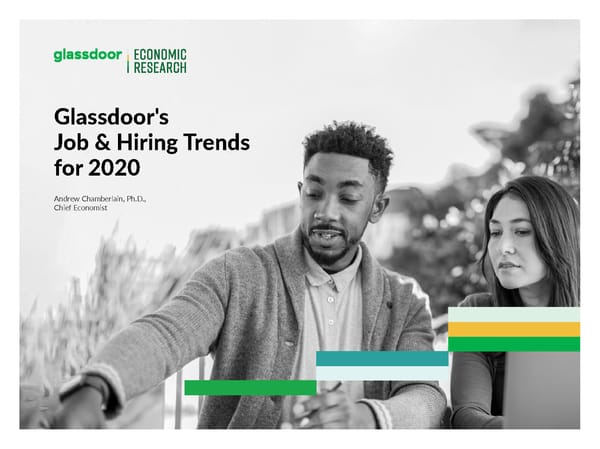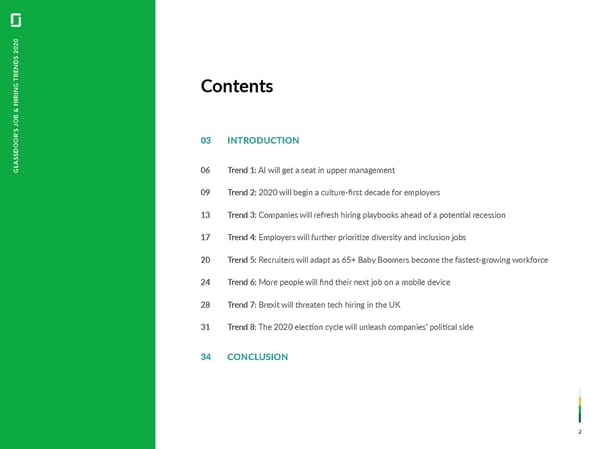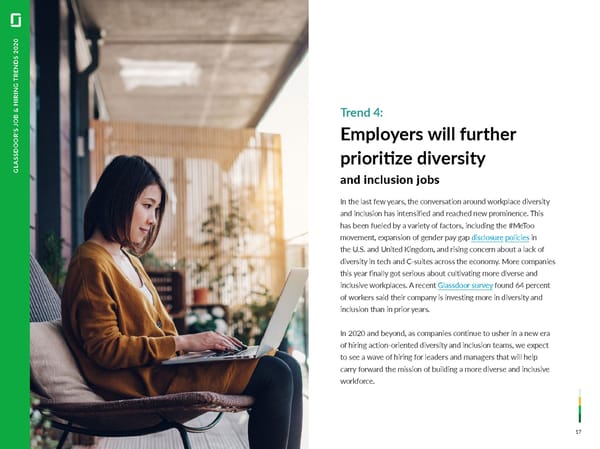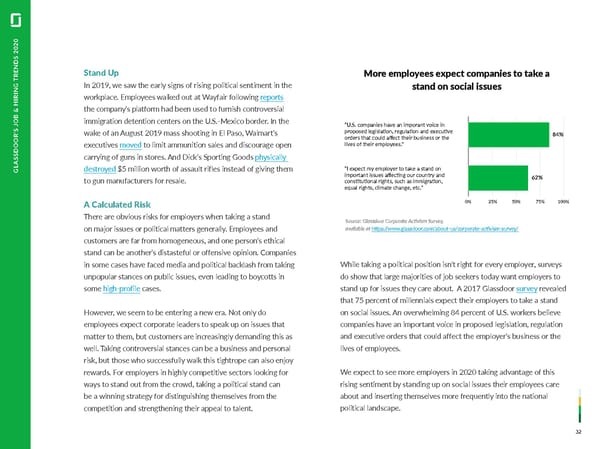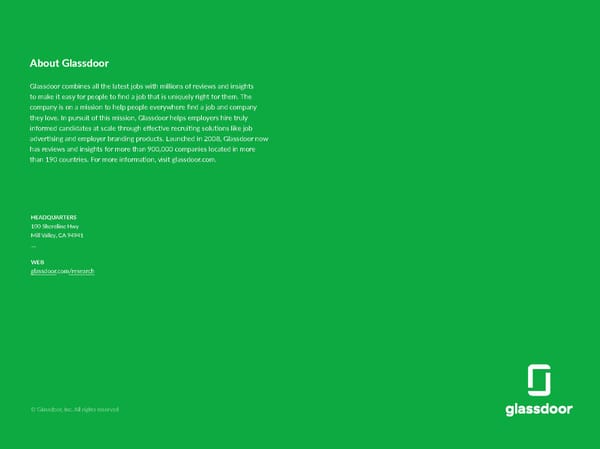Job & Hiring Trends
Interactive Economic Research | 35 pages
Glassdoor's Job & Hiring Trends for 2020 Andrew Chamberlain, Ph.D., Chief Economist
TRENDS 2020 Contents JOB & HIRING 03 INTRODUCTION GLASSDOOR'S 06 Trend 1: AI will get a seat in upper management 09 Trend 2: 2020 will begin a culture-first decade for employers 13 Trend 3: Companies will refresh hiring playbooks ahead of a potential recession 17 Trend 4: Employers will further prioritize diversity and inclusion jobs 20 Trend 5: Recruiters will adapt as 65+ Baby Boomers become the fastest-growing workforce 24 Trend 6: More people will find their next job on a mobile device 28 Trend 7: Brexit will threaten tech hiring in the UK 31 Trend 8: The 2020 election cycle will unleash companies’ political side 34 CONCLUSION 2
TRENDS 2020 JOB & HIRING Introduction This year was a whirlwind for talent professionals. A perfect storm of rapidly changing HR technology and GLASSDOOR'S a historically strong job market led to one of the most difficult hiring landscapes in a generation in 2019. What’s next for talent acquisition leaders as we enter a new decade in 2020? 3
The Hiring Struggle is Real TRENDS 2020 To see where we’re headed, let’s look back at where we stand. However, there are signs that the global economy is starting to Some of today’s hiring challenges, like tech talent shortages, are slow. In the U.S., employers added 2.09 million jobs in the past mostly beyond employers’ control. Candidates were in the driver’s year (as of October), the slowest pace in eight years. A U.S.-China JOB & HIRING seat in 2019, fueling a war for top talent in tech, healthcare and trade war has sent manufacturing hiring into a freefall. Several professional services. The unemployment rate dropped to near- high-profile U.S. tech IPOs have stumbled this year. The U.S. bond 50-year lows in both the United States and the United Kingdom, market has been flashing ominous recession warning signs for hitting 3.7 percent and 3.8 percent, respectively, in 2019. The U.S. months. In response, the U.S. Federal Reserve cut interest rates economy set records in July for the nation’s longest-ever economic this year — a sign that policymakers are worried about an economic GLASSDOOR'S expansion. And thanks to robust hiring, the number of unfilled jobs slowdown. Meanwhile, the ongoing political crisis surrounding hovered near an all-time high in both countries, with more than 7 Brexit has sharply dampened future prospects for many UK million vacant roles in the U.S. and more than 800,000 vacancies in employers. the UK. 4
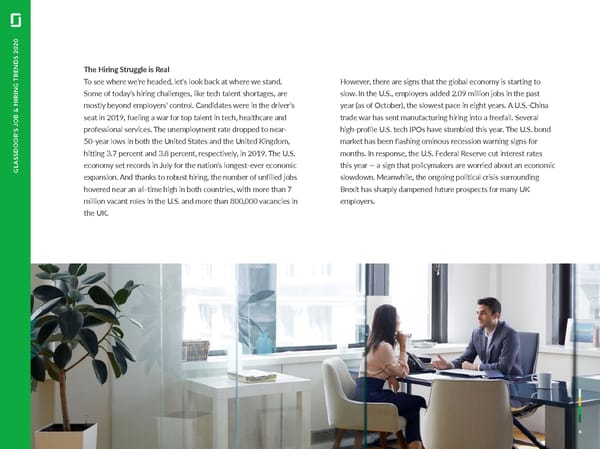
TRENDS 2020 JOB & HIRING GLASSDOOR'S Tech Changes Everything While the economy is beyond the control of employers, the What are the hiring disruptions to watch in 2020 and beyond? technology they use to hire isn’t. A revolution in the HR technology At Glassdoor, we have a unique vantage point with millions of space is underway. Artificial intelligence has matured from a company reviews, real-time job listings, salaries, and more from speculative future dream to a growing suite of affordable and around the world. This year, we’ve curated a list of eight HR and easy-to-use HR applications. Online workplace transparency is recruiting trends we anticipate for 2020 and what’s likely to shape continuing its march around the globe, with Glassdoor’s expansion the coming decade. into Asia and Europe. The rise of recruiting through social media and mobile devices is pressuring more employers to re-think whether traditional hiring models are ready for the digitally-savvy candidates of the future. 5
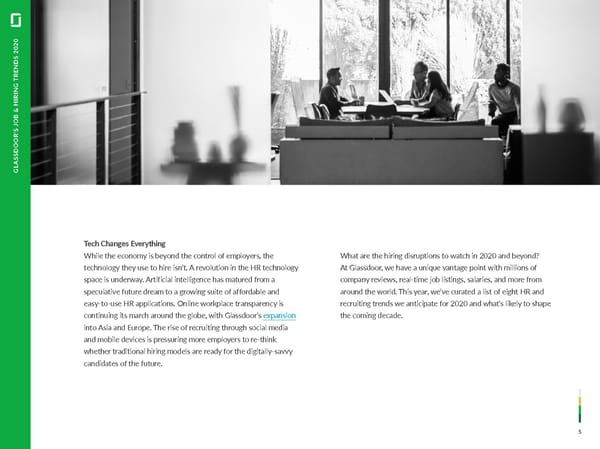
TRENDS 2020 JOB & HIRING Trend 1: GLASSDOOR'S AI will get a seat in upper management After years of speculation about artificial intelligence in the workplace, we got a larger glimpse into the future of AI at work in 2019. Against long-held fears that AI algorithms would replace large numbers of workers, artificial intelligence is instead showing up as a collection of more practical — and more widespread — productivity apps, like automated meeting schedulers, customer support chat bots, and AI tools that help identify and hire talent. 6
TRENDS 2020 What are some examples of AI tools taking over the routine Who's the Boss? jobs of managers today? They include: JOB & HIRING Although AI has been adopted in the workplace, there’s • UPS delivery’s well-known “telematics” system acts as one particular role we see ripe for AI advancement in 2020 an on-board AI supervisor for drivers, monitoring fuel and beyond: Management. Being a manager today isn’t only use, braking, time away from the driver’s seat, whether about being a leader who wields power and calls the shots they’re following optimal routes through cities, and more. in the workplace. It also involves a lot of less glamorous Plus, regular end-of-shift feedback reports to help drivers GLASSDOOR'S administrative work: Planning, budgeting, communication, and improve. routine performance reporting to senior leadership. These routine aspects of being a people manager today are ripe for • Retail sales productivity app Percolata is a sales takeover by improved AI algorithms in 2020 and beyond. optimization tool that assigns work schedules to employees via machine learning, doing a manager’s job This takeover of routine management tasks by AI tools is of assembling top-performing retail sales crews. It also already happening today. Some of the more interesting areas monitors in-store activity and rank-stacks sales employees of growing AI use is in real-time coaching and guiding of based on their real-world productivity. employees in their work — using big data to monitor employee tasks, give instant feedback to sales and customer service • Customer support call center app Cogito acts as an AI representatives, and make smart recommendations via an supervisor for workers, making real-time suggestions to algorithm. As AI technology matures in 2020 and beyond, we improve customer conversations during calls. It coaches expect to see many more employers using AI tools to augment employees to speed up or slow down, makes emotional these traditional management roles and tasks. IQ suggestions, and takes on the middle-manager task of reporting statistics for on-the-job employee performance to upper management. 7
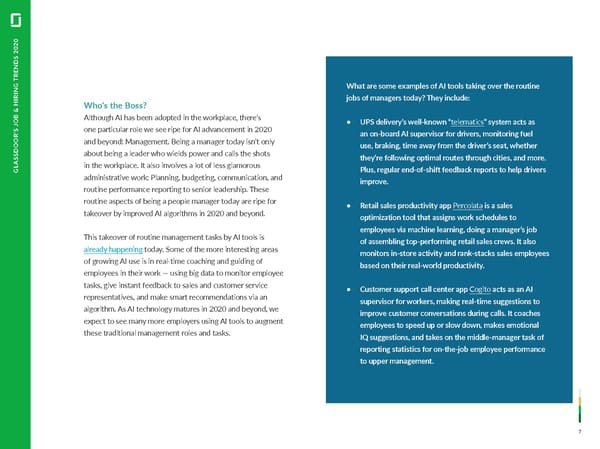
TRENDS 2020 In the late 2010s, there was a first wave of AI tools that automated The AI-Boss Partnership some of the more routine tasks of individual contributor roles, One way we may see employers adapting their workplaces for such as scheduling meetings, or doing basic customer service on more use of AI in management is by continuing to flatten their websites. Today, there is a second wave of AI tools coming online organizational structures. Companies have been flattening out JOB & HIRING that is focused increasingly on helping highly-skilled, and highly- their organizational structures for decades, in an effort to make paid, managers do their jobs better and at greater scale. managers co-equal partners and advocates for workers, rather than the traditional “boss” authority figure. We expect this The first wave of AI tools was mainly aimed at helping companies evolution to accelerate in 2020 and beyond, as companies look for ways to encourage employees and managers alike to view AI GLASSDOOR'S cut costs and reap small productivity gains. In the second wave of AI tools in 2020 and beyond, we expect more companies to use AI for systems as tools that help them excel at their jobs — rather than broader strategic gain -- freeing up skilled managers’ time to focus as an overbearing surveillance tool that issues unempathetic digital on essentially human tasks like long-term strategy, mentoring and commands to workers. cultivating talent, and driving an agenda of creativity and innovation. In the coming decade, watch for a new generation of workplace Not All That Glitters is Unbiased AI tools that support traditional management tasks: Offering While the use of AI tools for management tasks is likely to employees real-time feedback, monitoring performance, and accelerate in coming years, there are many risks and concerns. using big data to automate routine tasks of team leaders. Doing Many AI algorithms are not always transparent about how they so will increasingly allow managers to focus on strategy, creativity work, making it hard for business leaders to explain the “why” and mentoring, offering a powerful competitive advantage to behind AI recommendations. There are also growing concerns that employers who are able to harness this growing suite of AI tools. AI algorithms that are built using biased human data — such as an algorithm for hiring that uses data on previous hires, which may Although we don’t expect AI tools to come anywhere near to reflect a past hiring manager’s own bias -- may simply propagate replacing most managers, the evolution of AI from productivity biases forward and build it into enterprise software. Today, there tool for workers to partner for management will pose a host of are few regulations or disclosure requirements for AI tools, and little new workplace challenges in 2020 and beyond. is known about the long-term effects on the workplace of relying more heavily on AI software for traditional management tasks. 8
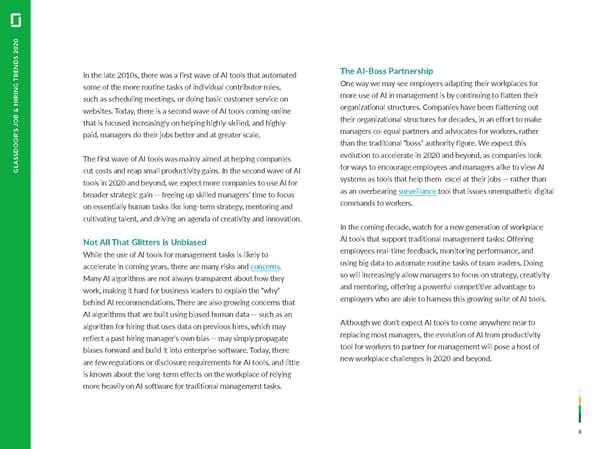
TRENDS 2020 Trend 2: JOB & HIRING 2020 will begin a culture-first decade GLASSDOOR'S for employers In August, a watershed decision regarding corporate priorities signaled a paradigm shift among some of the world’s most influential business leaders today. The Business Roundtable, a prominent group of nearly 200 CEOs from the world’s biggest brands, declared that shareholders were no longer the central purpose of today’s companies. The new mission statement — revised for the first time ever — states that employees are the focus of the modern corporation, along with customers, suppliers, and the broader communities in which companies operate. It’s hard to overstate the importance of this shift. This formal recognition of employee culture in business today is one that executives can’t afford to ignore. In 2020, we expect this changing tide of CEO opinion to usher in a new wave of culture-first thinking among business leaders, elevating employee engagement to the status of core business focus for a growing number of companies. 9
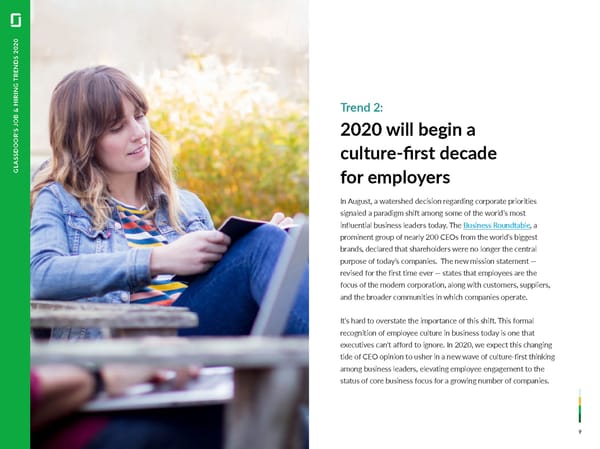
TRENDS 2020 The Culture Shift What trends have paved the way for this renewed focus on culture realize that their employees are their most important asset, not JOB & HIRING among executives? Even a decade ago, employee culture was the buildings or software that mattered most in the 20th Century viewed by CEOs as fluffy, hard to measure, and a nice-to-have. economy. Meanwhile, as a Glassdoor survey recently confirmed, But three fundamental trends have elevated the importance of workers increasingly prioritize company culture over cash. That employee sentiment throughout the economy in recent years: has made employee culture a non-negotiable core business issue; GLASSDOOR'S • First, online workplace transparency has become an accepted • Finally, an expansive collection of academic and private sector norm among job seekers. That has dramatically changed job research in the past decade has revealed the real-world business seeker behavior and companies’ ability to attract the talent impact of strong workplace culture. Employee culture has been they need. Candidates are investing more time and energy demonstrably linked to better financial performance, innovation, researching company culture before accepting jobs, and talent attraction, ethical workplace behavior, customer that has created a dynamic in which employers with strong satisfaction and more. While a decade ago there were few workplace cultures are enjoying a powerful strategic hiring studies able to draw this data-driven conclusion, today there are advantage; hundreds — an overwhelming intellectual shift that has changed the minds of CEOs about the deep impact of workplace culture • Second, jobs in every industry have continued to shift toward on businesses. knowledge-based work over the past decade — jobs where workers are highly differentiated, and where the motivation We believe these trends position 2020 to usher in a culture-first and knowledge of one individual worker can have a huge decade for employers — not just in tech and professional services but impact on a business. This shift is happening even in non-tech economy-wide, as growing numbers of companies come to rely on fields like health care, transportation, and manufacturing. the individual knowledge and creativity of their people as their core Businesses, especially high-performing ones, increasingly business asset. 10
TRENDS 2020 Proof-Points The Big 9 Cultural Values Company culture was once seen as a difficult to measure concept. But no longer. This year, Glassdoor and the MIT Sloan Management These key values are cited the most by leading companies Review launched the Culture 500, which breaks down the cultural and have the greatest impact on results. JOB & HIRING climate among employees at over 500 of today’s biggest companies using machine learning and the text of real-world Glassdoor reviews. This powerful tool allows even the most skeptical CEOs to easily AGILITY COLLABORATION CUSTOMER DIVERSITY EXECUTION GLASSDOOR'S understand and benchmark their employee culture against others in their industry. This measuring takes place along nine dimensions, including respect, innovation, customer orientation, and performance. We believe data-driven tools like these will help propel a culture-first INNOVATION INTEGRITY PERFORMANCE RESPECT revolution among CEOs in 2020 and beyond. The MIT SMR/Glassdoor Culture 500 uses machine learning to reveal company culture inside today's highest-performing companies. 11
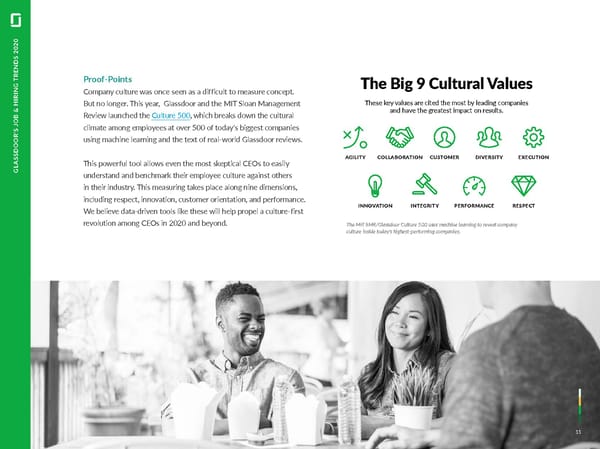
What Drives Culture A common misperception is that focusing on employee culture means The Workplace Factors that Matter Most TRENDS 2020 offering expensive workplace perks like onsite gyms, free meals, The Workplace Factors that Matter Most to Employee Satisfaction in the U.S. and unlimited vacation. But Glassdoor research has overturned that to Employee Satisfaction in the U.S. Culture & Values 22% idea. Being a culture-first organization isn’t about perks, but about Culture & Values 22% articulating a clearly-stated mission that resonates with employees’ Senior Leadership 21% JOB & HIRING Senior Leadership 21% own aspirations and fuels their best performance. Career Opportunities 19% Career Opportunities 19% Business Outlook 14% Business Outlook 14% In our five country study of what drives employee satisfaction, we Work-Life Balance 13% consistently found three core drivers matter most for long-term Work-Life Balance 13% GLASSDOOR'S Compensation & Benefits 12% employee satisfaction on Glassdoor: Compensation & Benefits 12% 0 5% 10% 15% 20% 25% 0 5% 10% 15% 20% 25% • A workplace with a clear mission connecting employees’ daily Source: Glassdoor Economic Research (Glassdoor.com/research) work to a broader social purpose and positive change in the world around them • High-quality senior leaders who are inspiring, empathetic, and competent The Workplace Factors that Matter Most The Workplace Factors that Matter Most to Employee Satisfaction in the UK • A set of clearly-defined pathways upward for workers, so that to Employee Satisfaction in the UK Culture & Values 22% jobs become a journey to the next rung of employees’ career Culture & Values 22% ladders, rather than a dead end. Senior Leadership 21% Senior Leadership 21% Career Opportunities 18% Career Opportunities 18% There has been a seismic shift in CEO opinion about the importance Business Outlook 14% Business Outlook 14% of individual talent and employee motivation in recent years. Work-Life Balance 13% Employee culture is becoming a core business issue in a growing Work-Life Balance 13% Compensation & Benefits 13% number of industries. In the wake of the Business Roundtable’s recent Compensation & Benefits 13% 0 5% 10% 15% 20% 25% shift toward employee focus among leading companies, we expect 0 5% 10% 15% 20% 25% to see more CEOs and talent attraction professionals embracing this culture-first business strategy in 2020 and beyond. Source: Glassdoor Economic Research (Glassdoor.com/research) 12
TRENDS 2020 Trend 3: Companies will JOB & HIRING refresh hiring playbooks ahead of a potential recession It has been more than 10 years since the last recession, the longest GLASSDOOR'S streak of good economic times in American history. So much time has passed since the last downturn that nearly half of U.S. companies today are so young that they’ve never weathered an economic recession. Today, many economic signals are flashing warning signs. The so-called “yield curve” from the bond market, which historically has been one of the best predictors of an approaching recession, signals that a slowdown is likely on the horizon. The economy’s pace of job gains has slowed this year from an average of 223,000 per month in 2018 to 167,000 per month so far in 2019. Meanwhile, the ongoing trade war with China is slowing manufacturing and creeping into other sectors. Although the job market remains strong for now, the risk of recession as we enter 2020 is higher than any time in the past decade. We expect to see many employers taking the risk of a recession more seriously in 2020 and beyond by updating their hiring and talent attraction playbooks in preparation. 13
TRENDS 2020 How to Weather A Storm How can employers position themselves to weather a possible JOB & HIRING economic slowdown? The first lesson about hiring during a recession is that talent attraction will still be a major challenge for employers. Rising Odds of a Recession Will Be A Talent Game-Changer in 2020 Although pools of applicants will be larger during a recession — a welcome relief for many HR professionals compared with the thin 40% GLASSDOOR'S applicant pools of today’s red-hot economy — that anticipated 37.9% surplus of job applicants in turn creates new challenges: how to separate quality talent from the pack when facing an ocean of 30% applicants. We expect to see more employers in 2020 prepare for this shift in 20% the candidate pool size by shifting toward higher-quality candidate channels. What do we mean by “higher quality” channels? We 10% expect employers to focus on candidate sources that deliver more well-matched candidates and a higher ratio of hires-to-applicants. These premium channels will become more important than ever 0% during a recession, as recruiting teams will be flooded with irrelevant 2010 2012 2014 2016 2018 2020 resumes from many sources. To filter out the noise, HR teams will double-down on reliable hiring channels that deliver high-quality Source: Federal Reserve Bank of New York. candidates — whether that’s referral networks that tap current high- performers, informed candidates who’ve utilized sites like Glassdoor to research company culture and pay, or other sources. 14
TRENDS 2020 JOB & HIRING GLASSDOOR'S Keep Flexible and Carry On A second way we expect to see companies brace for a possible There’s one trend in hiring we don’t expect to slow, even if recession in 2020 is by doubling down on flexibility. Even if it a U.S. recession materializes: employer emphasis on brand costs more in the short term, companies will aim for workforce image. Building a strong employer brand takes years, while most solutions that enable them to respond more fluidly in a downturn. recessions last nowhere nearly as long. Even if hiring slows in a Companies increasingly will shore up contract and part-time downturn, the need to differentiate from the competition will not. workforces and push less critical jobs to outsourcing and gig-style When the economy picks up and it’s time to ramp up hiring again, platforms. Like a palm tree in a hurricane, flexibility will enable companies who’ve maintained a strong employer brand will enjoy a companies to weather variability in revenue, which can swing clear strategic advantage. For that reason, we expect employers in greatly during a recession. 2020 to keep the long view and maintain investments in employer branding even if the economy slows. 15
TRENDS 2020 JOB & HIRING Build A Talent Contingency Plan During a recession, talent attraction professionals play a critical role inside companies. There will be many executive perspectives on how to react to a downturn — from leaders in finance, marketing, GLASSDOOR'S operations, sales and others. It’s important for talent leaders to have a seat at the table and make the case to CEOs for maintaining strong employee culture and protecting talent resources during a recession. The best strategy for protecting a company’s talent resources during a downturn is to develop a written talent contingency plan today, outlining a roadmap for prioritizing human resources with a special focus on protecting employee culture and branding in the unfortunate case of an economic downturn or recession. Doing so can help HR teams advocate for smart talent decisions during the emotional and volatile times of a downturn. In 2020, we expect to see more talent leaders making formal contingency plans to ensure they’re ready to weather the storm as a steward for virtually all companies’ most important asset: their people. 16
TRENDS 2020 Trend 4: JOB & HIRING Employers will further prioritize diversity GLASSDOOR'S and inclusion jobs In the last few years, the conversation around workplace diversity and inclusion has intensified and reached new prominence. This has been fueled by a variety of factors, including the #MeToo movement, expansion of gender pay gap disclosure policies in the U.S. and United Kingdom, and rising concern about a lack of diversity in tech and C-suites across the economy. More companies this year finally got serious about cultivating more diverse and inclusive workplaces. A recent Glassdoor survey found 64 percent of workers said their company is investing more in diversity and inclusion than in prior years. In 2020 and beyond, as companies continue to usher in a new era of hiring action-oriented diversity and inclusion teams, we expect to see a wave of hiring for leaders and managers that will help carry forward the mission of building a more diverse and inclusive workforce. 17
TRENDS 2020 Staffing Up Online Job Postings for Diversity & Inclusion Diversity and inclusion (D&I) programs have been Roles Soar on Glassdoor JOB & HIRING around for decades. But recently we’ve begun to see more employers, both in the U.S. and the UK, step up investments in D&I as a core business function. To do that, companies need expert leaders and managers United Kingdom 106% to operate these initiatives. It’s an effort we’re GLASSDOOR'S increasingly seeing and is a sign that companies are doubling down financially on efforts to recruit, hire and retain skilled talent who can move the needle on Germany 79% employee diversity inside companies. Online job postings for D&I jobs rose 30 percent in the U.S. between August 2018 and August 2019, France 53% with 810 job openings nationwide, according to new Glassdoor research. Demand for expertise in D&I were up much faster in other countries we examined as well: in the UK, hiring demand for D&I-related United States 30% roles surged by 106 percent from the prior year. Employers around the world are waking up to the need for robust diversity and inclusion efforts in 0 25% 50% 75% 100% 125% today’s economy, and are investing in the top talent Source: Daniel Zhao, "Increasing Investment in Diversity & Inclusion Job Market," Glassdoor to deliver on these programs. Economic Research report, October 2019. 18
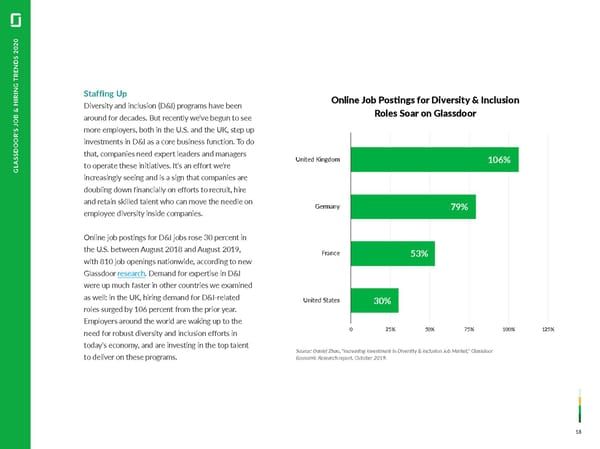
TRENDS 2020 An Attractive Role Big Companies Lead, For Now The rising interest in hiring D&I roles by employers is also matched Until now, most investments in hiring for D&I-related roles by growing job seeker interest in these positions. Our research have come from very large companies. Our research found JOB & HIRING shows that more job seekers are looking for D&I-related job that two-thirds of job openings in diversity and inclusion opportunities today, with searches up 35 percent over the past today are at employers with more than 1,000 employees. year in the U.S. and 19 percent in the UK. Given that there’s an The reason is simple: Large employers are subject to more average of 1.4 and 1.6 job seekers in the U.S. and UK, respectively, public and regulatory scrutiny, and also have more specialized GLASSDOOR'S for each open D&I-related role today, it’s good news for both job workforces allowing them to invest in dedicated diversity and seekers and companies hoping to staff up D&I teams in 2020 and inclusion teams. beyond. In 2020 and beyond, however, we expect more mid-sized What are the types of D&I talent employers need to hire? They employers to catch up on investments in diversity and range from program directors to specialized recruiters. As of August inclusion staff. This will be fueled by the need to compete for 2019, the most common D&I roles hiring on Glassdoor included: candidates who increasingly seek out companies with these programs. Ҍ D&I Director Ҍ Chief Diversity Officer Big changes have taken place in the last decade. Far more public discussion has taken place regarding the need to create Ҍ D&I Program Manager Ҍ Diversity Recruiter more diverse and inclusive workplaces. That momentum will spill into 2020 and beyond. As many companies have learned Ҍ D&I Manager Ҍ D&I Consultant over the last decade, words without action typically don’t lead to change. We expect the tide to turn in 2020, with more Ҍ D&I Specialist Ҍ Dean of Diversity & Inclusion companies putting their money where their mouths are by adding key D&I-focused employees in order to drive lasting Ҍ D&I Coordinator Ҍ Diversity Sourcer change in their workplaces. 19
TRENDS 2020 Trend 5: JOB & HIRING Recruiters will adapt as 65+ Baby Boomers become GLASSDOOR'S the fastest-growing workforce. The fastest growing segment of the labor force in the coming decade isn’t millennials or the newest band of Gen Z workers. It’s aging Baby Boomers. This demographic of age 65+ workers are working longer than past generations and, estimates show, aren’t going anywhere. They are healthier, work in physically less-demanding jobs, and are more in need of retirement income than previous generations — all forces which are keeping seniors in the workforce longer. A “gray wave” of senior citizens will be impacting the workforce in coming years, both in the United States and the United Kingdom. While the overall American labor force is projected to grow by 5.5 percent over the next decade, the 65+ workforce will grow by a whopping 61 percent. Similarly in the UK, the 65+ population is expected to rise nearly 60 percent over the next 25 years, faster than any other demographic group. 20
TRENDS 2020 Senior citizens today are healthier, more engaged, and working JOB & HIRING longer than past generations. But few employers today are well- positioned to make the most of this growing talent pool. Most talent attraction efforts today are focused on the hiring needs of tech-savvy Gen Z and millennial workers, rather than experienced seniors. In 2020 and beyond, we expect to see a dramatic shift GLASSDOOR'S in recruiting focus, with more strategies aimed at attracting the booming 65+ workforce and using it to companies’ strategic advantage. With Age Comes Opportunity There are many benefits to tapping the rising pool of 65+ talent. Many experienced workers have rich institutional knowledge and professional contacts that are hard to find among younger talent. Despite the perception of younger workers being more knowledge- nimble and tech-oriented, many employers find older workers are just as open to making investments in continuous learning and upskilling as their younger peers if given similar access. A workforce that is more age-diverse can also help boost “cognitive diversity,” drawing in valuable diverse viewpoints that research shows often drive more team creativity and innovation. 21
TRENDS 2020 Cultural Challenges This historic surge of 65+ workers in the coming decades is also workforce longer. In particular, the data show that extended senior likely to surface new challenges — most importantly, rising ageism citizen employment had no impact youth job opportunities or JOB & HIRING in the workplace — that employers will be under increasing wages. “If anything,” the researchers summarized, “the opposite is pressure to combat. According to a Glassdoor survey, 45 percent true.” That’s an important message for HR teams to communicate of employed adults in the U.S. and 39 percent in the UK have to younger workers in the coming decade. witnessed or experienced ageism in the workplace. Although employers around the globe have tackled important issues of GLASSDOOR'S QUESTION gender identity and ethnic diversity in the workplace in recent years, the issue of age bias has gotten much less attention — “Do you think people staying in the workforce longer is mostly a good something we expect to change in 2020 and beyond. thing or mostly a bad thing for American workers in general?” Mostly a good thing Mostly a bad thing A common myth that fuels ageism in many workplaces is a perception that by delaying retirement, older workers may be 50% hurting the career advancement of younger workers, blocking 50% their path to promotion. For example, a recent Associated Press 40% survey showed that younger workers have a much more negative 39% view than older workers of employees extending their time in the 30% 30% workforce; 50 percent of older employees viewed seniors working longer as positive for workers, while just 30 percent of younger 20% workers agreed. 19% 10% In reality, research shows that young workers have little to fear from older workers staying in the workforce longer. Using data 0% from 1977 to 2011, a study from Stanford’s Institute for Economic Younger Workers Older Workers (18 - 49 years) (50+ years) Policy Research shows no evidence that younger workers’ opportunities were diminished by older workers staying in the Source: Associated Press, NORC Center for Public Affairs Research. 22
TRENDS 2020 Learning & Inclusion Efforts Are Key The best way to prepare both seasoned workers and newer As employers brace for the coming “gray wave” in the workforce, JOB & HIRING generations in the coming decade is through investments in we expect to see more HR leaders rethinking what the “worker of learning and development. These efforts help workers of all ages today” looks like. Talent pools in the coming decade will be more keep skills fresh, promote a lifetime of learning, and help older diverse than ever — not just in terms of gender and ethnicity, but workers adapt to the warp speed of today’s technical innovation. also age and experience. Employers who broaden their definition Employers who invest in relevant, accessible learning programs of inclusivity to welcome older workers, and develop the learning GLASSDOOR'S in 2020 and beyond will be best positioned to attract, retain and programs to make the most of the 65+ talent pool, will enjoy a benefit from the aging workforce of tomorrow. strategic hiring advantage in 2020 and beyond. 23
TRENDS 2020 JOB & HIRING Trend 6: More people will find their GLASSDOOR'S next job on a mobile device Twelve years ago, the launch of the Apple iPhone forever changed how the world accessed the internet. Through easy-to-use touchscreens, the smartphone opened the door to mobile apps that radically changed how people use the internet in their busy, daily lives. In less than a decade, mobile devices have become ubiquitous. We now rely on them for dating, shopping, driving directions, bank balances, restaurant and travel information, the news -- and searching and applying to jobs. As more aspects of our lives move onto mobile devices, the use of traditional desktop PCs is rapidly declining. That tectonic shift is having a huge impact on candidate experiences today. In 2020, we expect to see employers wake up to the importance of streamlining their mobile job application experiences. Older legacy systems risk losing out on candidates when outdated application systems aren’t mobile phone friendly. 24
TRENDS 2020 The Future Is Mobile Applications take longer, and see less completion JOB & HIRING According to research from the World Advertising Research Center rates on mobile devices today (WARC), in only 5 years from now nearly three quarters (72.6 percent) of internet users will exclusively access the web through Desktop Mobile a smartphone. Desktop internet experiences are rapidly going 12 47% 50% the way of the land line or, more accurately, the VCR. That means 10.5 45% GLASSDOOR'S the candidate of the future will largely show up to employers’ 10 40% application portals via mobile phone. If their application process 35% isn’t mobile-first, companies may lose out on talent attraction. 8 +80% +53% 30% At Glassdoor, we recently studied more than 12 million active 6 5.9 25% job seekers on Glassdoor and found that mobile device users 22% 20% face many more application barriers than their desktop-using 4 counterparts. The median time to complete a job application for 15% mobile users took 80 percent longer than traditional desktop 2 10% PCs — 10.5 minutes per application on mobile, compared to 5% 5.9 minutes on desktop. That large difference in job application 0% difficulties translates into smaller candidate pools for recruiters: 0 Candidates on mobile devices complete only about 22 percent of Median Time to Complete Percent of Applications Application (Minutes) Completed applications they start, compared to 47 percent on desktop. Source: Daniel Zhao, “The Rise of Mobile Devices in Job Search: Challenges and Opportunities for Employers,” Glassdoor Economic Research report, June 2019. 25
TRENDS 2020 JOB & HIRING GLASSDOOR'S Impact on Candidate Diversity The poor experiences job seekers face when applying on a mobile • Often outside today’s biggest metro areas; cities with the device represents lost opportunities for employers. By deterring most mobile device applicants include Riverside, California; mobile-only applicants, employers are hurting the size and diversity Orlando, Florida; San Antonio, Texas; and Detroit, Michigan — of their candidate pools. Our research shows candidates who rely not high-cost tech hubs like San Francisco, New York City or more on mobile devices during the job hunt have a different profile Seattle, as many might assume. than candidates who use desktop devices. They are: • More likely to apply to blue-collar, lower-skilled, and non- • Older and more experienced; 35-44 year-olds are the most tech jobs; the highest share of mobile-device applicants likely to apply on a mobile device — not the young, tech- were to jobs for package handler (75.4 percent mobile savvy candidates many assume would rely on mobile phones devices), restaurant manager (75.1 percent mobile devices), for job hunting. truck driver (73.9 percent mobile devices), certified nursing assistant (72.9 percent mobile devices), and materials handler • More likely to be women; 52 percent of mobile device (72.8 percent mobile devices) — not the software engineers applicants are female, compared to 46 percent of desktop and data scientists many would assume rely on mobile applicants. By making mobile applications difficult, companies phones for job applications. are baking in a gender diversity disadvantage in their applicant pools. 26
TRENDS 2020 Social Media Recruiting Listing jobs as Easy Apply on Glassdoor There is growing interest today in social media recruiting — automatically makes them simple and easy for JOB & HIRING attracting candidates from non-traditional sources like Facebook, mobile-device applicants Twitter, Instagram, and other social media apps. One of the most common ways these candidates will arrive to company job portals will be on a mobile device. Most legacy applicant tracking systems GLASSDOOR'S today are not ready to deliver great candidate experiences to these mobile applicants — a risk that could stymie companies’ social recruiting investments. In 2020 and beyond, we expect to see more employers streamlining mobile job application flows in preparation for the coming shift toward mobile-only candidates. Tools like Glassdoor’s “Easy Apply” can integrate with many existing applicant tracking systems, and automatically optimize jobs for a simple, easy-to- use mobile applicant flow. As the world becomes more reliant on mobile devices in coming years, we expect to see employers invest much more in mobile-friendly candidate experiences. Source: Glassdoor 27
TRENDS 2020 JOB & HIRING Trend 7: GLASSDOOR'S Brexit will threaten tech hiring in the UK Depending on how, or when, it’s done the United Kingdom’s planned departure from the European Union will have a dramatic impact on UK hiring and talent attraction in 2020 and beyond. Whether the UK ends up leaving the EU, we expect Brexit-related uncertainty to have a major business impact. If a full Brexit occurs, the aftermath and any changes in immigration rules will affect UK employers— particularly those struggling to fill in-demand tech roles, which are disproportionately filled by globally mobile candidates working outside their country of citizenship. 28
TRENDS 2020 Job Fears and Brain Drain Share of UK executives who see Brexit among According to a recent Glassdoor survey, 40 percent of employees top 3 sources of business uncertainty in the UK say that Brexit has resulted in their company cutting Salzburg Date UK was JOB & HIRING jobs. Meanwhile, UK employers fear a possible tech “brain drain” Summit due to leave 65 following a hard Brexit. Similarly, a recent survey of 1,000 UK 60 business leaders by Salesforce found more than half of employers surveyed said they believe the country is at risk of a brain drain 55 GLASSDOOR'S after Brexit, particularly for tech talent. Severing the decades 50 old UK-EU relationship will likely erect new immigration barriers for skilled workers, making it much harder for the world’s top 45 software engineers and other tech talent post-Brexit to live and 40 work in the UK. 35 These looming questions about the impact of Brexit on jobs and 30 Sep Jan Apr Jul Oct Jan Apr Jul Oct Jan Apr Jul hiring have spurred a growing climate of uncertainty in the UK. 2016 2017 2018 2019 According to the Decision Maker Panel, which surveys a nationally representative sample of around 8,000 UK financial officers from Source: UK Decision Maker Panel, available at https://decisionmakerpanel.co.uk small, medium and large companies, business uncertainty from Brexit is on the rise. The nearby figure shows the share of survey A recent survey of over 2,100 employers by the Chartered Institute respondents who said Brexit was among the top 3 current sources of Personnel and Development found that more than half of UK of uncertainty they’re struggling with — hitting 57 percent in employers had no knowledge of government plans for post-Brexit August 2019. immigration rules, and only 7 percent had detailed knowledge of the latest proposals. We expect this to become the single biggest Other surveys show most UK employers today are not yet issue facing talent attraction professionals in the UK’s tech and prepared for the new immigration rules that may accompany Brexit. professional services sectors in 2020. 29
TRENDS 2020 The Costly Unknown When it comes to business, uncertainty itself can be extremely interest in remote and flexible work arrangements, as hiring JOB & HIRING harmful. It makes planning and investment more difficult. It managers struggle to relocate in-demand talent to UK office discourages companies from taking risks and making long-term locations. Employers’ Brexit-related immigration challenges will plans. And it diverts executives’ time and energy toward bracing further accelerate the already growing trend toward remote for worst-case contingencies rather than working toward their core work, which has been fueled in recent years by improved instant business goals. messaging and video conferencing tech in the workplace. GLASSDOOR'S There’s growing evidence that Brexit-related uncertainty is already Second, we expect UK-based employers to shift their focus to hurting UK employers. A recent working paper from the National cities outside the UK for tech-related hiring. Since major cities like Bureau of Economic Research in the U.S. found that Brexit Dublin and Paris — each only a 1-hour flight from London — will anticipation has reduced investment spending by British firms by remain in the EU, employers can still take advantage of more about 11 percent since the original June 2016 Brexit vote. It found flexible intra-EU immigration rules from there. Although splitting up the Brexit process has hurt UK workforce productivity by between company workforces geographically has many disadvantages, it still 2 and 5 percent, mostly due to companies diverting more time to may outweigh the high costs and uncertainty posed by immigration Brexit-related planning. According to the study, Brexit has also led policies in a post-Brexit world. That’s especially true for high to a large and long-lasting increase in business uncertainty in the demand tech roles, a need met today by hiring talent originating UK — something that may also spill over into deteriorating business outside the UK. outlooks for non-UK employers who hire and do business in the United Kingdom. Holistically, the UK economy is strong and most UK employers will emerge from Brexit largely unscathed. However, we expect The Path Ahead big changes in how UK-based employers cultivate new talent and In 2020 we expect to see two main responses to Brexit-related navigate post-Brexit immigration policies in today’s increasingly hiring challenges by UK employers. First, we anticipate a greater global high-skilled workforce. 30
TRENDS 2020 Trend 8: JOB & HIRING The 2020 election cycle will unleash companies’ GLASSDOOR'S political side The single biggest external event facing Americans in 2020 is the looming U.S. Presidential election. All eyes and conversations across media, workplaces and home life will shift to the national political stage. That comes after increasing levels of political awareness and polarization over the last three years, fueled by an acrimonious and divided political climate, a seemingly endless stream of political controversies, and the launch of a presidential impeachment investigation. In 2020, we expect to see more workplaces get political as both employers and employees engage with the national election cycle. In particular, we’re likely to see more companies and employees embracing their stances on social issues in 2020, potentially impacting both employer branding and day-to-day workplace culture. 31
TRENDS 2020 Stand Up More employees expect companies to take a In 2019, we saw the early signs of rising political sentiment in the stand on social issues workplace. Employees walked out at Wayfair following reports the company’s platform had been used to furnish controversial JOB & HIRING immigration detention centers on the U.S.-Mexico border. In the “U.S. companies have an imporant voice in wake of an August 2019 mass shooting in El Paso, Walmart’s proposed legislation, regulation and executive 84% orders that could affect their business or the executives moved to limit ammunition sales and discourage open lives of their employees.” carrying of guns in stores. And Dick’s Sporting Goods physically destroyed $5 million worth of assault rifles instead of giving them “I expect my employer to take a stand on GLASSDOOR'S important issues affecting our country and to gun manufacturers for resale. constitutional rights, such as immigration, 62% equal rights, climate change, etc.” A Calculated Risk 0% 25% 50% 75% 100% There are obvious risks for employers when taking a stand Source: Glassdoor Corporate Activism Survey, on major issues or political matters generally. Employees and available at https://www.glassdoor.com/about-us/corporate-activism-survey/ customers are far from homogeneous, and one person’s ethical stand can be another’s distasteful or offensive opinion. Companies in some cases have faced media and political backlash from taking While taking a political position isn’t right for every employer, surveys unpopular stances on public issues, even leading to boycotts in do show that large majorities of job seekers today want employers to some high-profile cases. stand up for issues they care about. A 2017 Glassdoor survey revealed that 75 percent of millennials expect their employers to take a stand However, we seem to be entering a new era. Not only do on social issues. An overwhelming 84 percent of U.S. workers believe employees expect corporate leaders to speak up on issues that companies have an important voice in proposed legislation, regulation matter to them, but customers are increasingly demanding this as and executive orders that could affect the employer’s business or the well. Taking controversial stances can be a business and personal lives of employees. risk, but those who successfully walk this tightrope can also enjoy rewards. For employers in highly competitive sectors looking for We expect to see more employers in 2020 taking advantage of this ways to stand out from the crowd, taking a political stand can rising sentiment by standing up on social issues their employees care be a winning strategy for distinguishing themselves from the about and inserting themselves more frequently into the national competition and strengthening their appeal to talent. political landscape. 32
TRENDS 2020 Other Ways of Leaning In Taking a political stance as a company isn’t the only way for The big takeaway for employers is that there will be opportunities JOB & HIRING employers to tap into job candidates’ desire to work for socially and risks in speaking up in the politically charged climate of 2020. conscious employers. Glassdoor surveys also show that giving back We expect to see more employers in highly competitive talent to communities is another issue that’s more important than ever to spaces doubling down on their mission and values in this election employees today. According to one poll, 75 percent of U.S. workers year, both by taking a public stance on social issues and investing said they expect their employer to support groups and individuals in employee volunteering and other modes of corporate social GLASSDOOR'S responsibility as they ride the tumultuous wave of the 2020 in need in their communities, either through donations or volunteer efforts by employees. election cycle. 33
TRENDS 2020 Conclusion Today’s hiring market presents more challenges to talent JOB & HIRING professionals than ever before. Workplaces are becoming more transparent, and new technologies are changing how companies find, hire, and retain talent. While rapidly changing HR tech has sparked anxiety among some talent professionals, it also presents immense GLASSDOOR'S opportunities for employers in the coming decade. The choice of where to work is one of the most important decisions in most peoples’ lives. The job market today is doing a better job of matching people with their best possible career opportunities than ever before. However, the same technology that’s making job markets work more effectively is also rapidly changing the future of work for many jobs themselves -- with growing AI and automation impacting managers and HR professionals today, as well as employees. The U.S. economy is approaching a turning point as we approach 2020 and the start of a new decade. After a decade of growth and unemployment rates still remaining near historic lows, there are signs of a slowing economy. With today’s rapidly changing HR tech landscape comes new challenges as well. That makes 2020 an opportune time for employers to position themselves to benefit from the hiring trends we’ve presented — and to invest in workplace culture today while the economic times are good. 34
About Glassdoor Glassdoor combines all the latest jobs with millions of reviews and insights to make it easy for people to find a job that is uniquely right for them. The company is on a mission to help people everywhere find a job and company they love. In pursuit of this mission, Glassdoor helps employers hire truly informed candidates at scale through effective recruiting solutions like job advertising and employer branding products. Launched in 2008, Glassdoor now has reviews and insights for more than 900,000 companies located in more than 190 countries. For more information, visit glassdoor.com. HEADQUARTERS 100 Shoreline Hwy Mill Valley, CA 94941 __ WEB glassdoor.com/research © Glassdoor, Inc. All rights reserved

